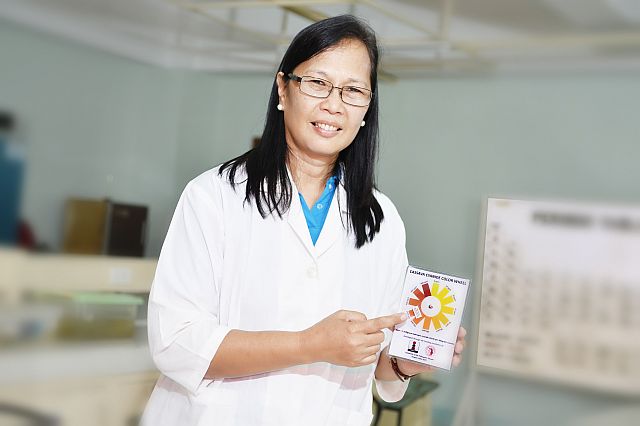This article is originally posted on the Cebu Daily News website, and is written by Cris Evert Lato.

In 2015, Dr. Vivian Azucena-Topor heard the news that 31 students from Suclaran National High School in Guimaras fell ill after eating cassava cake.
The Ilongga chemistry professor of the University of the Philippines–Visayas (UPV) in Miag-ao, Iloilo, who selected “molecular studies on cassava” as her dissertation, was alarmed by the news.
“I had to do something to educate people so we can avoid cases of cyanide poisoning from cassava consumption,” said Topor, who is also the director of the Graduate Program Office at the UPV campus in Iloilo City.
Her commitment was translated into the “Cassava Cyanide Color Wheel Kit,” a simple and easy-to-use product which can be used by technicians and farmers in the field to check cyanide content of cassava variants.
Her invention of the kit earned Topor a place in the 2016 roster of honorees of an advocacy campaign, The Many Faces of the Teacher (TMFT), run by Bato Balani Foundation Inc. and Diwa Learning Systems. Topor, described as a community biochemist, was one of four teachers from among a dozen finalists nationwide who were honored at the Waterfront Cebu City Hotel and Casino on Oct. 1 during an annual awarding event leading to the celebration of the Teachers’ Day on Oct. 5.
To use Tobor’s poison-detecting kit, a 100-mg cassava sample is placed inside a flat-bottom vial and is mixed with phosphate buffer solution. A peak rate paper is then introduced to the vial and is allowed to sit for 16 hours. The color of the paper changes.
Farmers can analyze the result using the color wheel where the darker color indicates higher percentage of cyanide. Topor drew inspiration from a testing kit sent to her from Australia.
“But I thought that we cannot always ask other countries every time we need something. If we can innovate, why not?” she said.
Education
Cassava earned the reputation of being a dangerous root crop after a 2005 incident in Mabini, Bohol, claimed the lives of 30 children.
But Topor was quick to note that not all cassava variants are harmful to humans.
She said there are variants with higher cyanide percentage, which are used for making alcohol and starch, but there are variants fit for human consumption.
“People need to be educated about the nature of cassava to eliminate the fear of this root crop,” she said. Topor said cyanide is released by a cassava plant to protect itself from predators.
Industry standards note that variants with zero to 50 parts per million (ppm) are considered nontoxic variants. Between 50 to 100 ppm is moderately toxic while 100 and above is dangerously toxic.
This does not mean, however, that raw cassava with 150 ppm cannot be consumed.
Preparation
But there are several ways to significantly bring down the cyanide levels in cassava.
When cooking cassava, Topor said the root crop should be peeled and cut in small pieces. When boiling cassava, do not put a lid over the pot.
“Cyanide is volatile, and it can escape at 26 degrees Celsius,” she said.
Topor said cassava is the kind of root crop that is not best eaten “fresh” or when just newly harvested.
She advised waiting two to three days before cooking the root crop as a freshly harvested cassava has higher cyanide content.
Married to African national Wollor Topor (also a professor who is a dean of a university in Liberia) who considers cassava as a staple food, Topor said she has learned to appreciate different ways on how cassava is prepared.
One of these products is gari, which is made from grated raw cassava.
At home, Topor said, the grated cassava is placed in a jute sack. The sack is tied and is left to ferment for three to seven days. The process helps reduce and detoxify the cyanide content of cassava.
Seminars
Topor hoped that the education seminars she conducts would encourage farmers to plant more cassava especially that the DA is providing them with planting materials.
“I met many farmers who want to regain their productivity, but they just don’t know what to do,” she said.
Topor donated the first batch of kits to the Suclaran Barangay Council, fulfilling her promise to contribute to community education on food safety.
But Topor did not just stop here.
She built alliances and partnerships with the local government units and the Department of Agriculture so she can educate people about cassava in the Western Visayas region.
“My recommendation is to immediately spot-check the backyard farms planting cassava. Using the kits, we can immediately identify which variants produce higher levels of cyanide. If this is the case, the LGU can urge the farmers to replace the crop,” said Topor.
